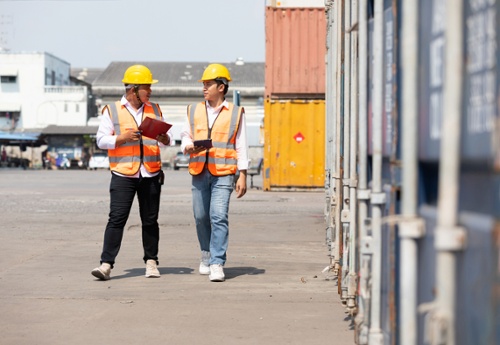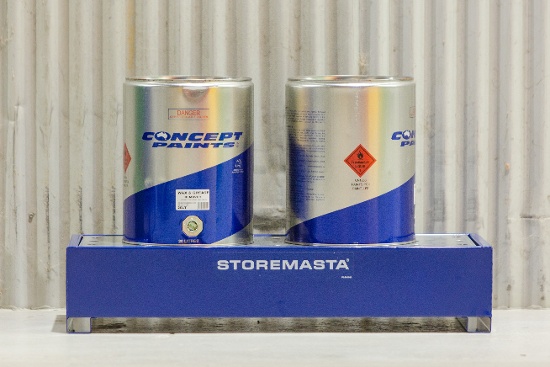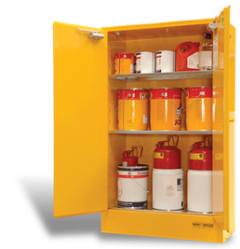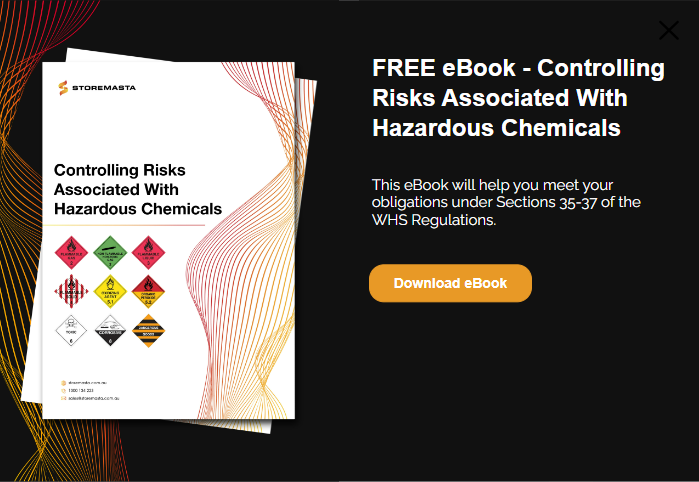When working with dangerous goods, it’s important to have control measures in place that can minimise the impact that an accident would have, not only on your staff and your facilities but the surrounding environment. The mismanagement of dangerous goods, such as flammable solids, oxidising agents and corrosive substances, can result in hazardous situations such as fuel spills or acid leaks. So as part of your action plan to minimise the risks, bunding and secondary containment methods are required. In this blog, we detail why bunding is important, how it can be integrated into your secondary containment plan and how you can calculate spill bund capacity.
Bunds & Secondary Containment
Secondary containment is the method of containing leaks or spills if the primary containment measures fail. Secondary containment is an essential hazard prevention strategy that is specifically designed to prevent the substances from escaping the storage facility or immediate workplace. If liquids do escape the containment area, there is the increased risk of hazard.
For example, a spill of Class 3 substances may release sufficient flammable vapours to spark a fire if there is an ignition source present. Alternatively, a Class 8 spill may result in corrosive chemicals damaging vehicles, tools and equipment in an uncontained work area.
Bunds are a key component of any secondary containment strategy. Placed around the perimeter of the containment area, bunding is designed to stop chemical spills from spreading further.
Where Do You Need Bunding?
The placement of bunds is highly tailored to meet the unique needs of each dangerous goods storage situation. Bunding can be a permanent fixture or a portable mobile solution, depending on the needs of your organisation. Bunding is used as a secondary containment method in both indoor and outdoor situations. It may be a series of IBC bunds for an outdoor area, collapsible bunds for transport operations or permanent floor bunding for your warehouse. Bunding solutions are often a combination of many of these different bunding products.
Wherever your secondary containment area is situated, it must be constructed to ensure the sufficient containment of your organisation’s supply of dangerous goods. You must also be aware that a secondary containment area should designated to a sealed area — without drains that lead outside the area or to the stormwater system.
What Is Bund Capacity?
Simply put, bund capacity is the bunded area that contains your spill. There is no ‘one size fits all’ approach to determining the maximum capacity for the bund, as this is determined by the volume of dangerous goods that you are containing, as well as the classification of those substances. The Environmental Protection Authority (EPA) recommend that bunding and secondary containment requirements are determined on a site-by-site basis.
Bunding Capacity For Dangerous Goods
To effectively determine your bunding requirements, a thorough risk assessment of your site is recommended. However, there are specific guidelines for each class of dangerous goods detailed in the Australian Standards. You can use these requirements as your spill bund calculator to ensure you’re containing spills in a safe and compliant way.

We recommend conducting a full risk assessment onsite to properly determine the bunding requirements for your organisation.
Bund Capacity Calculator Requirements
Following the requirements of the relevant Australian Standard for your class of dangerous goods will allow you to calculate your spill bund requirements.
But remember, incompatible substances must be segregated with separate bunds to reduce the risk of chemical hazards in the workplace. We also encourage you to seek the assistance of a qualified Dangerous Goods Consultant if you are creating a custom storage facility with spill bunding for your facility. This will help you accurately identify and assess all the risks associated with your onsite chemicals.
IMPORTANT: Refer to AS/NZS 3833 - The storage and handling of mixed classes of dangerous goods to learn more about dangerous goods segregation.
Class 3 – Flammable Liquids
As stated in AS 1940:2017 – The storage and handling of flammable and combustible liquids:
4.4.3 Spillage containment
(d) The capacity of the spillage containment compound shall be at least 100% of the volume of the largest package plus 25% of the storage capacity up to 10 000 L, together with 10% of the storage capacity between 10 000 L and 100 000 L, and 5% above 100 000 L.
Flammable liquids require steel bunds which can not melt or combust if there is spillage.
Class 4 – Flammable Solids
The AS/NZS 5026:2012 – The storage and handling of class 4 dangerous goods states that:
4.21 Design safety and suitability
(l) Spill control measures to avoid contamination of soil and water. Where dangerous goods can ignite on exposure to air, establish a method to contain any spillage so that air cannot come into contact with the spilt dangerous goods.
Class 5.1 – Oxidizing Agents
As per the Australian Standard AS 4326:2008 – The storage and handling of oxidizing agents:
4.4 Design and construction of package stores
(j) Where liquid oxidizing agents are kept, the storage area shall be provided with a means of either containing a spill or diverting it to a safe containment area within the boundaries of the premises. The net capacity of any containment area shall be—
- for PG I liquids, 100% of the aggregate volume of liquids kept; and
- for liquids of PG II or III, 25% of the aggregate volume of liquids kept.
In any case, the net capacity of any spill containment provision shall be at least the capacity of the largest container kept.
Class 5.2 – Organic Peroxides
AS 2714:2008 – The storage and handling of organic peroxides states that:
4.7.4 Spillage control
The floor of each indoor room or compartment shall either—
- incorporate a compound that holds at least 25% of the volume of liquid organic peroxides stored or the capacity of the largest container, whichever is the greater; or
- be provided with an enclosed drain that—
(a) is fitted with a flame trap; and
(b) leads to a bunded compound or impervious sump.
Where fire sprinklers are installed, the capacity of the compound or sump shall be increased to include the output of the fire sprinklers over a 20 minute period.
Class 6 – Toxic Substances
The Australian Standard AS/NZS 4452-1997 – The storage and handling of toxic substances details that:
4.4 General requirements for package stores
(a) Stores shall be provided with a means of either containing a spill or diverting it to a compound within the boundaries of the premises. The net capacity of any compound shall be—
- For Packing Group I liquids, 100% of the aggregate volume of liquids kept.
- For Packing Group II and III liquids, 25% of the aggregate volume of liquids kept
In any case, the net capacity of any compound shall be at least the capacity of the largest container kept.
The compound shall be impervious to the material it is designed to contain.
NOTES:
1 In order to facilitate the management of emergencies, it is recommended that compound capacities be about 10% greater than the minimal values specified above.
2 Earth by itself without a lining does not satisfy the impermeability criteria given above.
Class 8 – Corrosive Substances
AS 3780:2023 – The storage and handling of corrosive substances states that:
4.4 General requirements for package stores
(a) Stores, other than those for closed lead-acid batteries, shall be provided with a means of either containing a spill or of diverting it to a compound within the boundaries of the premises. The net capacity of any compound shall be not less than whichever is the greater of—
- 25% of the aggregate volume of liquids kept; or
- the capacity of the largest container kept;
but need not exceed 5000 l where only packages are kept.
Class 9 – Miscellaneous Dangerous Goods
As stated in AS/NZS 4681-2000 - The storage and handling of Class 9 (Miscellaneous Dangerous Goods) dangerous goods and articles:
3.3.4 Spillage containment for package stores
Where liquids are to be stored, spillage containment shall be provided. This may be achieved by using a bund or by having a means of diverting a spill into a compound within the premises, e.g. by installing spoon drains or sloping floors.
The following requirements apply to spillage containment:
- The capacity of the spillage containment compound shall be at least 100% of the volume of the largest package, plus 10% of the total storage capacity, up to a maximum of 5000 L.
- The spillage containment system shall be constructed of materials that are resistant to attack by the materials being stored.
- The capacity of on-site containment shall be increased to include the output of any fire protection sprinklers over a 20-minute period.
NOTE: In order to facilitate the management of emergencies, it is recommended that compound capacities be about 10% greater than the minimal values specified above. - The compound shall be impervious to the materials it is designed to contain.
NOTE: Earth by itself without a lining does not satisfy the impermeability criteria given above. - Provision shall be made so that spills cannot run directly into drains which lead to outside the premises. Emergency procedures shall be in place to block or cover drains in the event of an emergency.
Bund Capacity Compliance
When selecting dangerous goods storage equipment for your operations, you need to ensure that the bunding meets the requirements of the Australian Standards. This will help you maintain safety at your site in the event of a chemical spill, as well as ensure compliance.
Safety cabinets are a bunded storage solution that feature a spill containment compartment below the bottom shelf. This Storemasta Oxidizing Agent Cabinet features a compliant liquid-tight spill sump to contain leaks and spills.
You can ask your manufacturer for a Certificate of Compliance for your dangerous goods storage equipment, so you have proof that the storage unit is meeting the requirements of the Australian Standards.
REMEMBER: All Storemasta indoor safety cabinets are constructed with liquid-tight spill bunds that meet the requirements of the relevant Australian Standard. The spill sump depth (ie the bund wall) in Storemasta indoor chemical cabinets (up to 250 L capacity) is designed 150mm deep, which ensures compliance. Cabinets over 250 L must be able to contain 25% of their capacity.
What You Need To Know About Bunding & Secondary Containment
Secondary containment is only one element of an effective site management plan for spill and leak prevention. It’s also crucial that organisations are equipped with an accurate understanding of their risks and armed with the right secondary containment products, as well as a team who know how to use them. If you want to know more about bunding and secondary containment, or you need advice on how to calculate spill bund capacity for your workplace, we can help. You can access our easy-to-read guide Controlling Risks Associated With Hazardous Chemicals to learn to control chemical hazards with our risk management methodology, IDENTIFY - ASSESS - CONTROL - SUSTAIN. Get your copy today to learn more about creating a safer workplace.

Living life by the 4 C’s of marketing – communication, coffee, compliance… and more coffee – Leisa Andersen is Storemasta’s Content Marketing Manager. When she’s not writing, you’ll find her enjoying all the good things in life, including shopping, travel and gluten free donuts.


